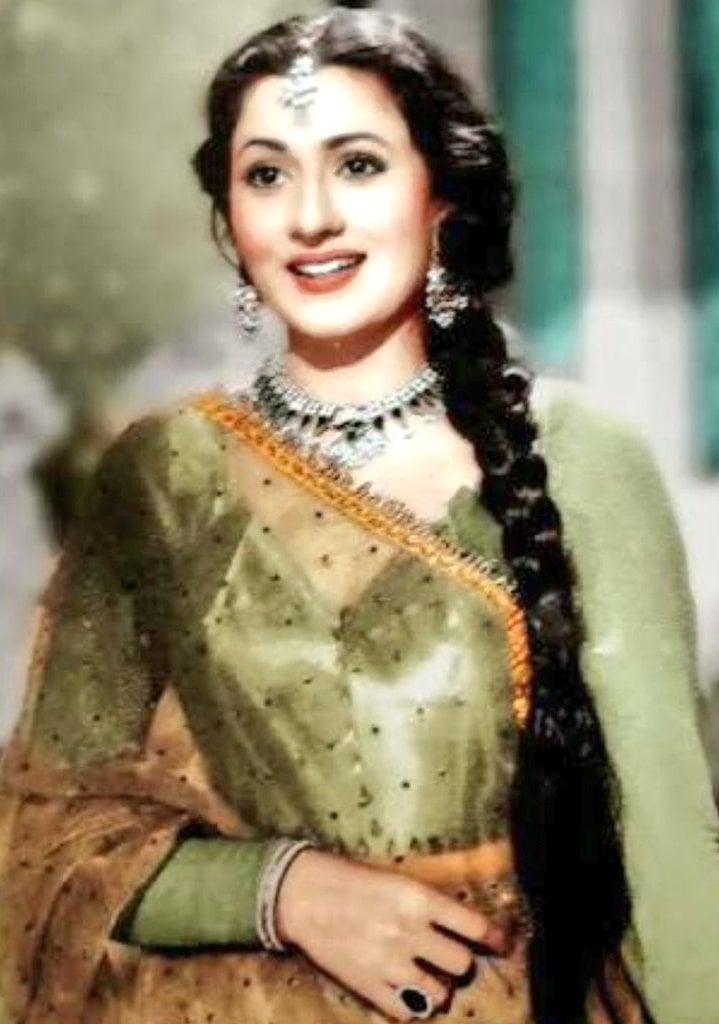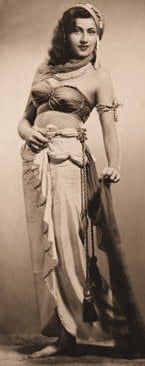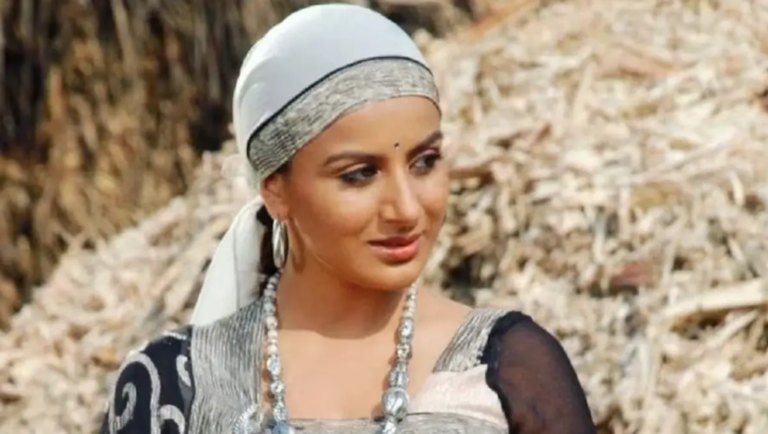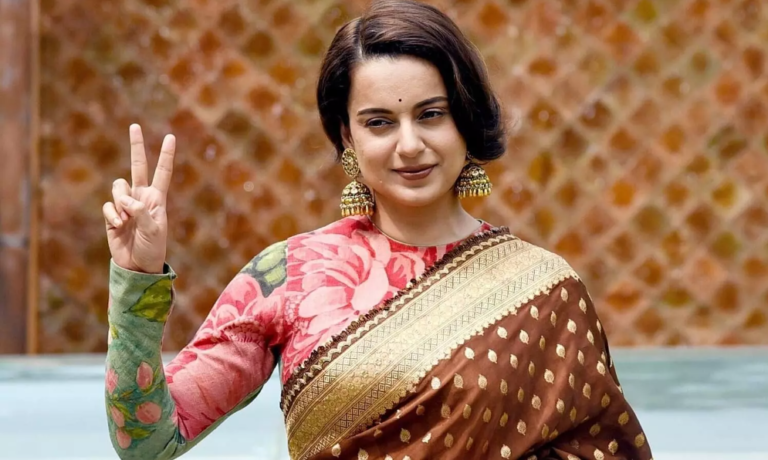
| Bio/Wiki | |
|---|---|
| Real name | Begum Mumtaz Jehan Dehlavi |
| Names earned | • The Venus of Indian Cinema • The Marilyn Monroe of Bollywood • The Beauty With Tragedy |
| Profession(s) | • Actor • Producer |
| Physical Stats & More | |
| Height (approx.) | in centimeters– 170 cm in meters– 1.70 m in feet & inches– 5’ 7” |
| Weight (approx.) | in kilograms– 55 kg in pounds– 121 lbs |
| Figure Measurements (approx.) | 34-26-30 |
| Eye Colour | Black |
| Hair Colour | Black |
| Career | |
| Debut | As an actor • Film: Basant (1942) as ‘Manju’ (child actor) As a producer • Film: Naata (1955) |
| Last Film | Sharabi (1964) |
| Personal Life | |
| Date of Birth | 14 February 1933 (Tuesday) |
| Birthplace | Delhi, British India |
| Date of Death | 23 February 1969 |
| Place of Death | Bombay (now Mumbai), Maharashtra, India |
| Age (at the time of death) | 36 Years |
| Death Cause | Ventricular Septal Defect (VSD) (Hole in the Heart) |
| Zodiac sign | Aquarius |
| Nationality | • British Indian (1933-1947) • Indian (1947-1969) |
| Hometown | Delhi, India |
| School | Madhubala did not attend any school, but she was taught at home by an English tutor. |
| Religion | Islam |
| Controversies | Charity Sparks Religious Backlash Reportedly, in 1950, Madhubala donated Rs. 5000 each to the Jammu and Kashmir relief fund and children suffering from poliomyelitis. She further donated an amount of Rs. 50,000 to the refugees from East Bengal. She received wide media coverage for the donations but faced criticism due to different religious beliefs.Received a Lawsuit Over an Advance Payment When Madhubala’s father, Ataullah Khan, denied her outdoor shooting with Dilip Kumar in Bhopal for the film ‘Naya Daur'(1957), B.R. Chopra sued her for the advanced money that she received for this movie. Dilip Kumar also testified against Madhubala and her father in the court in favour of Chopra. |
| Relationships & More | |
| Marital Status (at the time of death) | Married |
| Affairs/Boyfriends | • Prem Nath • Dilip Kumar • Kishore Kumar |
| Marriage Date | Year, 1960 |
| Family | |
| Husband/Spouse | Kishore Kumar |
| Children | Madhubala had no children. |
| Parents | Father– Ataullah Khan (worked with ‘Imperial Tobacco Company’ in Peshawar) Mother– Ayesha Begum |
| Siblings | Brother– None Sister– 7 • Altaf • Chanchal • Kaneez Fatema • Shahida Kazi • Madhur Bhushan (Zahida) Note: According to sources, Madhubala’s parents had 11 children, four boys and seven girls; however, the boys couldn’t survive. [1]Filmfare |
| Favourites | |
| Food | Chaat, Ragda Pattice, Pani Puri |
| Dessert | Kulfi |
| Jewellery | Gold and Kundan |
| Song | ‘Rulake Gaya Sapna Mera’ from the film “Jewel Thief” (1967) |
| Style Quotient | |
| Car Collection | Madhubala’s impressive car collection included a Hillman, Buick, and Station Wagon, among other swanky cars. [2]Filmfare |

Some Lesser Known Facts About Madhubala
- Madhubala, a renowned figure in Hindi cinema, was an Indian actress and producer. Her enchanting natural beauty and graceful demeanor have established her as a beloved icon among audiences. Madhubala received immense praise for her performances in notable films such as ‘Neel Kamal’ (1947), ‘Amar Prem’ (1948), ‘Chalti Ka Naam Gaadi’ (1958), ‘Half Ticket’ (1962), and numerous others. Tragically, she passed away in 1969 due to congenital heart disease.
- She was a member of a traditional Muslim Pashtun family. [3]Filmfare
- According to reports, Madhubala did not go to school, but she received education from an English tutor at her home. This vintage photograph beautifully captures the innocence of Madhubala’s childhood.
- During an interview, Madhubala’s sister, Madhu, disclosed that due to her father Ataullah Khan losing his job at Imperial Tobacco Company in Delhi, Madhubala and her family relocated to Bombay (now Mumbai). They settled in the Kandivali/Malad suburb, which was conveniently located near Bombay Talkies, a prominent movie studio. Tragically, on 14 April 1944, their residence was destroyed in an explosion at the Victoria Dock in Bombay, British India.
- Madhubala, only 9 years old at the time, ventured into acting with her debut in the Indian romantic musical film ‘Basant’ in 1942, before the partition. This film achieved immense success, becoming the highest-grossing Indian film of the year, with Madhubala portraying the character ‘Manju’. Following this triumph, she secured her first starring role in the film ‘Neel Kamal’ (1947).
- According to reports, while filming ‘Basant’ (1942), Devika Rani, the film’s producer, was captivated by Madhubala’s ethereal beauty. Impressed by her charm, she requested her to adopt ‘Madhubala’ as her stage name.
- After the song ‘Aayega Aanewala’ from the movie ‘Mahal’ (1949) became a hit, Madhubala started including a clause in her contracts stating that Lata Mangeshkar was her preferred playback singer. Mangeshkar mentioned Madhubala’s admiration for her and said, “After the success of Aayega Aanewala in Mahal (1949), she made it clear in her contracts that she exclusively wanted me to handle her playback singing. We used to frequently meet socially back then, but unfortunately, that kind of close bond no longer exists. Madhubala used to meet me with a great deal of affection.” [5] – The Indian Express
- The Dispatch reported that Madhubala starred in the movie ‘Hanste Aansoo’ (1950), the first film to be awarded an “A” rating by the Central Board of Film Certification, indicating it was strictly for adults.
- In 1951, Madhubala and Prem Nath, an Indian actor and director, entered into a romantic relationship. However, their relationship came to an end after six months due to their differing religious backgrounds. It is reported that Prem Nath asked Madhubala to convert to Hinduism, but she refused. In an interview, Madhubala’s youngest sister, Madhur Brij Bhushan, expressed that their love initially flourished but sadly ended because of their religious differences.
- Madhubala and Dilip Kumar crossed paths when they were both involved in a project, shortly after Madhubala’s separation from Prem Nath. It is believed that their love for each other blossomed while working together on the film ‘Tarana’ (1951), which featured both of them as the lead actors. The duo went on to collaborate in several other films like Sangdil (1952) and Amar (1954), and eventually decided to take their relationship to the next level. Despite their contrasting personalities – Madhubala being outgoing and vibrant, while Dilip Kumar was known for his reserved nature – they got engaged after dating for a while. [8] Filmfare magazine has even captured a picture showcasing the bond between Madhubala and Dilip Kumar.
- She founded ‘Madhubala Private Ltd.’ in 1955 and produced numerous films in which she also starred. Some of the films produced under her banner were ‘Mehlon Ke Khwab’ (1960) and ‘Pathan’ (1962).
- Madhubala received a nomination for the Filmfare Award for best actress in 1960.
- Madhubala and her family were forced to move to Andheri in a villa called “Kismet” after their house was destroyed in the 1944 explosion at the Victoria Dock of Bombay, British India. However, they had to sell the villa due to the failure of the film “Naata” (1955) at the box office. Eventually, they found a new home in the “Arabian Villa,” a bungalow rented by Madhubala on Peddar Road in Bombay. This became their permanent residence until her death. The “Arabian Villa” was owned by Madhubala and is well-known as her Bombay residence.
- The engagement of Dilip Kumar and Madhubala led to a conflict between Dilip Kumar and Madhubala’s father, Ataullah Khan, while they were filming “Naya Daur” in 1957. The film crew had planned to shoot in Gwalior, where a mob had attacked women during the filming of another movie. However, Ataullah Khan expressed concern about his daughter’s safety and requested a change in the shooting location. Despite the complaint filed by Ataullah Khan, the director and producer, B.R. Chopra, decided to stick with the original location and replaced Madhubala with Vyjayanthimala. During the court hearing, Dilip Kumar supported B.R. Chopra’s decision, causing a rift between him and Ataullah Khan. This conflict had a negative impact on Madhubala and Dilip Kumar’s relationship, ultimately leading to their breakup. In an interview, Madhubala’s sister, Madhur Bhushan, explained that the breakup occurred due to a court case during the filming of “Naya Daur” when Ataullah Khan requested a change in the shooting location for safety reasons. Despite Dilip Kumar’s support for B.R. Chopra, this disagreement caused cracks in their relationships and ultimately led to the breakup.
- According to Madhubala’s sister Madhur, Dilip Kumar’s unexpected support for the Chopras during the case caused great distress to Madhubala, leading her to frequently cry during that time. After a period of separation, they tried to reconcile and had phone conversations about it. During these conversations, one point was consistently brought up: Dilip Kumar proposed that Madhubala should leave her father and marry him, while Madhubala insisted that he first apologize to her father before she would consider marrying him. Madhur mentioned in an interview that they engaged in these phone conversations in an attempt to reconcile. Dilip Kumar persistently urged her, saying, “If you leave your father, I will marry you.” In response, Madhubala would say, “I am willing to marry you, but please return home, apologize, and embrace him.” Unfortunately, the “perfect match” never reconciled as neither of them was willing to compromise on their respective “requirements”.
- Some media outlets attribute the reason for Dilip Kumar and Madhubala’s failure to reconcile to Ataullah Khan’s objection to their relationship. However, Dilip Kumar, in his autobiography titled ‘Dilip Kumar: The Substance and The Shadow’, explicitly stated that Madhubala’s father had ulterior motives of turning their marriage into a profit-making venture by making them work for his production house. Dilip Kumar strongly disagreed with Ataullah Khan’s intentions, ultimately leading to the unfortunate end of his love story with Madhubala. In his autobiography, Dilip Kumar reminisced about his experiences while filming the iconic historical drama film ‘Mughal-E-Azam’ and mentioned that their relationship started deteriorating due to her father’s business-oriented plans for their marriage. He also mentioned that director K. Asif tried to resolve the situation for Madhubala, but unfortunately, it resulted in them not even speaking during the production of ‘Mughal-E-Azam’.
- got married in 1960 after Madhubala’s relationship with Dilip Kumar ended. Madhubala met Kishore Kumar while he was in the process of divorcing his previous wife. Leena Chandavarkar, Kishore’s fourth wife, believes that Madhubala decided to marry Kishore just to prove that she could marry anyone she wanted after realizing that Dilip Kumar was not going to marry her. Madhur Bhushan, Madhubala’s sister, claims that Kishore and Madhubala fell in love while working on different films and their relationship lasted for about three years.
- Kishore Kumar allegedly converted to Islam and assumed the name Karim Abdul in order to marry her.
- Madhubala was diagnosed with a Ventricular septal defect, which led to a lung issue caused by high pulmonary pressure. She frequently experienced coughing as a result. Madhur, in an interview, revealed that Madhubala’s illness was discovered in 1954 while shooting the film ‘Chalak’ in Madras, when she vomited blood. In response, Kishore Kumar and Dr Rustom Jal Vakil flew from Mumbai to London to seek treatment for her. According to some sources, Kishore Kumar and Madhubala went to London for their honeymoon and also arranged for her specialized treatment there. Madhur mentioned in an interview that doctors in London informed Kishore Kumar about the severe damage to Madhubala’s heart and predicted that she had only two years left to live. Around 10 days later, Kishore Bhaiyya took her to London, as Madhur Bhushan explained, where the doctors declared that her heart was irreparable and she would not survive beyond two years.
- In an interview, Madhur Bhushan revealed that despite being advised by doctors to take three months of bed rest, Madhubala chose to ignore it in order to maintain the quality of her films. During the filming of Mughal-e-Azam, she was compelled to wear chains and walk around with them, causing immense stress. Consequently, her hands would turn blue by the end of each day. Madhubala even went to the extent of refusing food, believing it was necessary to portray the anguished and weary look required for the jail scenes. One memorable scene from the film ‘Mughal-E-Aazam’ involved Madhubala being bound by chains as she prepared for a captivating shot. Madhur recalled that while shooting Mughal-e-Azam, Madhubala had to act out a scene in which she was shackled with chains and had to walk around in them, resulting in her hands turning blue by the end of the day.
- Her disease became widely known in the mid-1950s, leading to her being branded as “box office poison.”
- During an interview, Ashok Kumar, the brother of Kishore Kumar, discussed the deteriorating health of Madhubala and noted that her illness had caused her to become easily angered, leading her to spend most of her time at her father’s house. Madhur Bhushan, Madhubala’s sister, also revealed that Kishore Kumar had taken Madhubala to their father’s house and requested his assistance in taking care of her, as he would frequently be away for work. Kishore Kumar explained, “I am often occupied with outdoor commitments, making it difficult for me to personally attend to her needs.” Additionally, Madhur disclosed that Kishore Kumar took responsibility for all of Madhubala’s medical expenses and made regular visits every two months to see her.
- According to sources, Madhubala’s health was extremely poor, requiring her to receive oxygen every four to five hours. Additionally, the doctor would regularly extract blood from her body due to an overproduction. Filmfare reported that her health deteriorated to the point where she became extremely thin. When looking at herself in the mirror, Madhubala would express disbelief at her own appearance, stating that she would cry even more if anyone dared to comment on it. Madhubala’s sister, Madhur, disclosed that she used to cry and express a strong desire to stay alive, hoping for the doctors to find a remedy instead of perishing.
- Due to her declining health, Madhubala decided to adopt an intermittent work schedule. Her final movie, released in 1964, was titled ‘Sharabi’.
- After realizing her acting career in the film industry had come to an end, she made the decision to venture into movie direction. Her directorial debut was supposed to be the film ‘Farz Aur Ishq,’ but unfortunately, her serious health problems prevented her from completing it.
- Madhubala passed away on 23 February 1969 in Bombay (now Mumbai) due to congenital heart disease. She was laid to rest at the Juhu Muslim Cemetery in Santacruz, Bombay. During her funeral, Kishore Kumar was seen supporting her coffin on his shoulder. Madhubala’s father spent several weeks at the cemetery, supervising skilled craftsmen as they intricately carved her grave from pristine marble. The memorial at her resting place included verses from the Koran and dedicated lines in her memory. In 1969, Prithviraj Kapoor paid a visit to Madhubala’s final resting place.
- According to reports, the grave of Madhubala and others in the Juhu Muslim Cemetery was destroyed in order to make room for new burials. The cemetery held the graves of several notable individuals, including Naseem Bano, Ludhianvi, Naushad, Ali Sardar Jafri, Khwaja Ahmed Abbas, Jan Nisar Akhtar, Rafi, and Parveen Babi. In an interview, Asgar Ali, the president of the Muslim Majlis, a trust responsible for managing the burial ground, discussed the demolition of the graves and explained that the act was necessary to accommodate new burials. He also mentioned that constructing memorials for the deceased goes against Islamic law. Asgar Ali explained, “According to Islamic law or Sharia, it is not permitted to build memorials for the deceased. Additionally, due to the increasing Muslim population in the area and their preference for burial in our prestigious and well-maintained cemetery, space has become limited. Even the poet Ali Sardar Jafri, who lived near Malabar Hill, was laid to rest in our cemetery.” [24] The Economic Times.
- During an interview, Madhur disclosed that after Madhubala’s passing, Dilip Kumar and his family visited the cemetery, only to find out that the burial had already occurred. Additionally, she mentioned that Dilip’s family graciously sent them food for the following three days after Madhubala’s demise.
- During the closing ceremonies of the 2004 Athens Olympics, Stelios Kazantzidis, a renowned Greek singer, presented a Greek song called ‘Mandoubala’ as a tribute to Madhubala.
- The India Post released a commemorative postage stamp in 2008 to honor Madhubala.
- In 2010, Filmfare included Madhubala’s portrayal of ‘Anarkali’ in the movie ‘Mughal-e-Azam’ on its list of the top ’80 Iconic Performances’ [26]. Tanqeed Mughal-e-Azam is regarded as one of the most exceptional films ever created, according to surveys conducted by the British Film Institute and News 18 [27].
- Madhubala’s statue, inspired by her appearance in the film Mughal-E-Azam, was revealed at the New Delhi branch of Madame Tussauds on 10 August 2017. Madhur Bhushan graced the occasion and was captured standing next to the Madhubala statue at the event held in Madame Tussauds, New Delhi.
- In 2018, The New York Times, an American newspaper, featured an obituary in their ‘Overlooked’ section, drawing a parallel between the life of Madhubala and Marilyn Monroe, two iconic American actors. [28]
- According to reports, Sukanya Verma, an Indian journalist and film critic, included Madhubala’s entry in “Mughal-E-Aazam” in Rediff.com’s compilation of “20 scenes that left us breathless.”
- Google celebrated the 86th birthday of the legendary Madhubala on 14 February 2019 by creating a doodle in her honor. The doodle was a delightful tribute to Madhubala, who was not only known for her mesmerizing beauty but also for her versatile acting skills. She effortlessly portrayed various roles in comedies, dramas, and romantic films, thanks to her subtle style. Despite her career being tragically cut short, Madhubala managed to leave her mark by appearing in over 70 films. In fact, back in 1952, Theatre Arts magazine acclaimed her as “The Biggest Star in the World.” Today, we remember her on what would have been her 86th birthday.
- Madhubala, who had mastered driving by the age of 12, possessed an impressive fleet of luxurious cars consisting of Hillman, Buick, and Station Wagon. According to Filmfare, she occasionally indulged in the pleasure of embarking on lengthy drives.
- Madhubala would don a burqa due to her affiliation with a conservative Muslim family.
- Madhur Bhushan reveals that Madhubala had a fondness for plain white sarees and enjoyed embellishing her hair with mogra, also referred to as Arabian Jasmine. In the Filmfare magazine, Madhubala is depicted with grace, wearing a beautiful white saree.
- During an interview, Madhur disclosed that Madhubala had no acquaintances and was prohibited from attending any premieres or events. [32]Filmfare
- Despite Frank Capra’s desire to provide Madhubala with international recognition by casting her in Hollywood films, her father, Ataullah Khan, consistently refused to permit her to work in the industry.
- Madhubala, famous for her stunning looks and compassionate nature, was recognized for her philanthropic endeavors. According to reports, in 1954, it was revealed that Madhubala regularly granted monthly bonuses to the lower-level employees working at her studios. Additionally, in 1962, she generously donated a camera crane to the esteemed Film and Television Institute of India (FTII).
- Released after the filmmaker’s death, the movie ‘Jwala’ (1971) stood as the sole color film in that category.
- Sources indicate that Madhubala had an extensive filmography in Tamil, Telugu, and Malayalam cinema as well.
- During an interview, Madhur Bhushan, the sister of Madhubala, characterized her as a highly emotional and jovial individual who effortlessly transitioned between laughter and tears. Madhur disclosed that once Madhubala started laughing, it became quite challenging to halt her laughter, often leading to the cancellation of shooting sessions. [33] Filmfare
- According to certain media sources, Madhubala is said to have had a childhood friend named Latif in Delhi, British India (now India). Before leaving for Bombay (now Mumbai), Madhubala supposedly gifted Latif a rose as a token of her affection. Latif, who eventually became an IAS officer, cherished the rose and placed it on Madhubala’s grave after her passing. It is believed that Latif pays a visit to Madhubala’s grave on the 23rd of February each year. [34]
- Madhubala was honored with numerous titles, such as ‘The Venus of Indian Cinema,’ ‘The Marilyn Monroe of Bollywood,’ and ‘The Beauty With Tragedy.’
- Madhubala’s exceptional beauty captivated people worldwide, leading to her photographs being prominently featured in esteemed foreign magazines like the American LIFE magazine. Additionally, her charm was celebrated in the August 1952 edition of the ‘Theatre Arts’ journal, which included a stunning photograph of her. The article, titled “The Greatest Star on the Planet – and she’s not residing in Beverly Hills,” bestowed upon her an additional honor. In fact, the 1952 edition of ‘Theatre Arts’ journal dedicated a special article solely to the iconic Madhubala.
- Pradeep Kumar and Bharat Bhushan were among the many actors whose hearts were captured by her irresistible charm, and both of them had expressed their love to her.
- Dev Anand reflected on her memory, stating that she had a fondness for flirting and would innocently play one person against another.
- Madhubala harbored a deep affection for animals, particularly dogs, and her abode was home to a delightful assortment of 18 furry companions.














+ There are no comments
Add yours